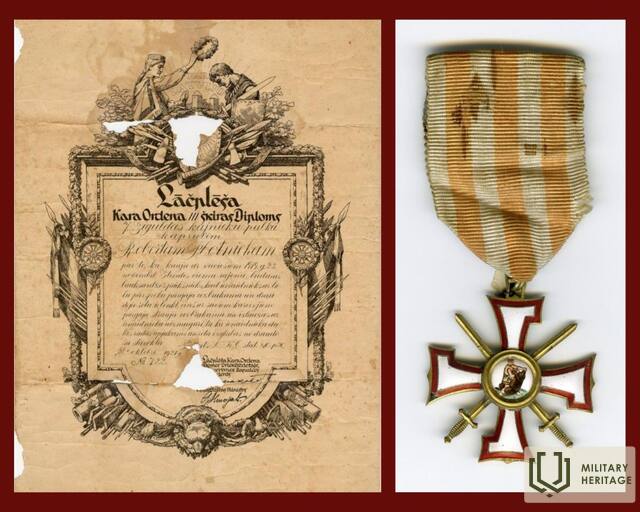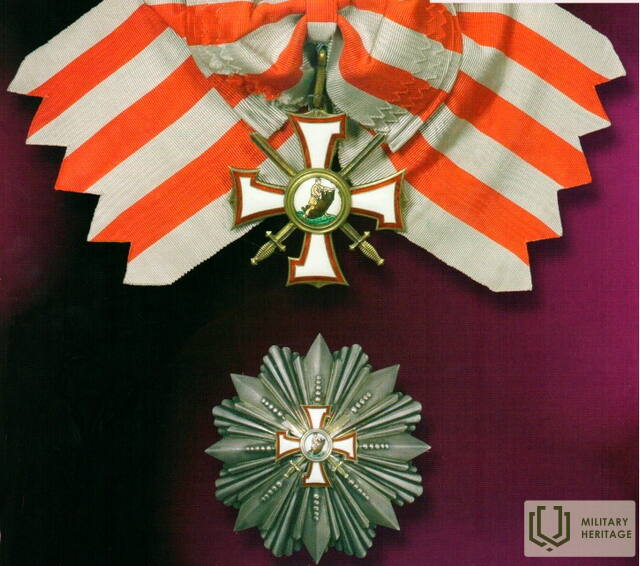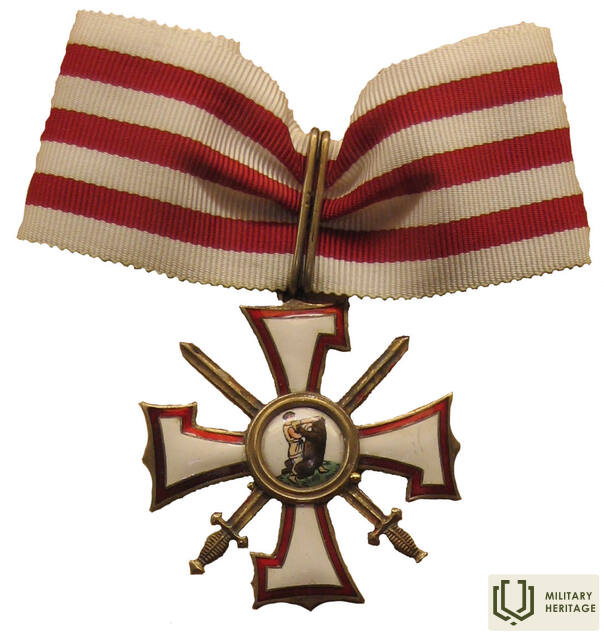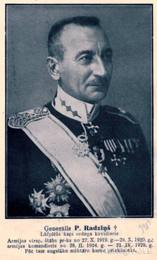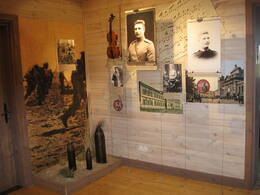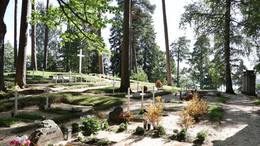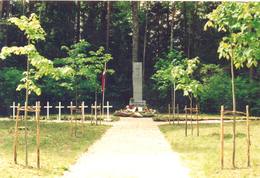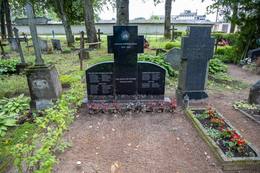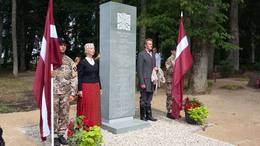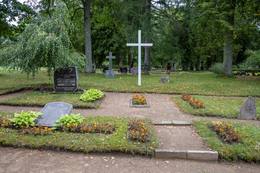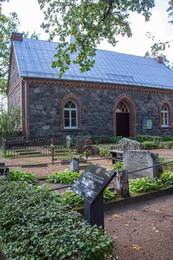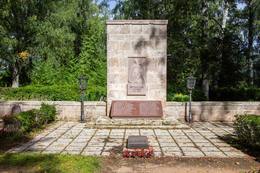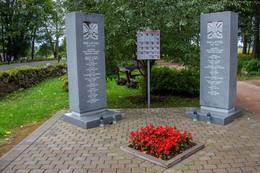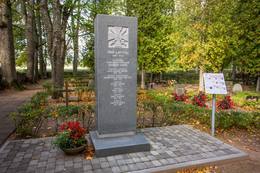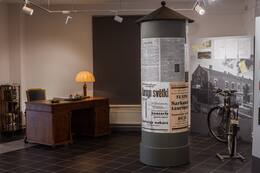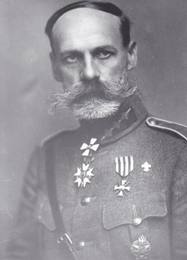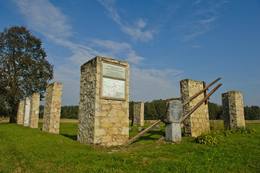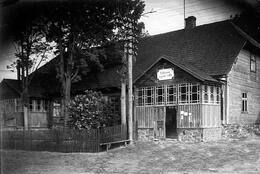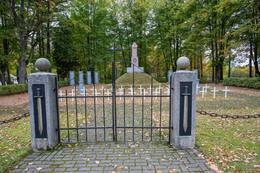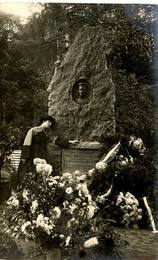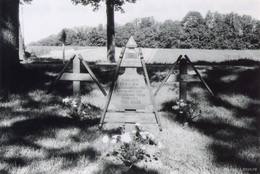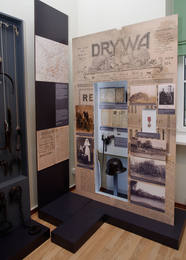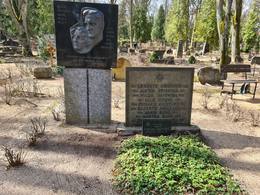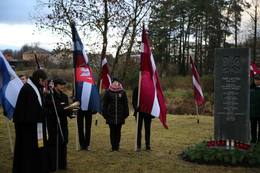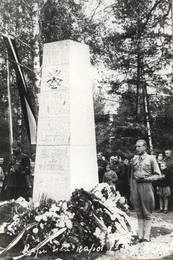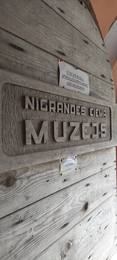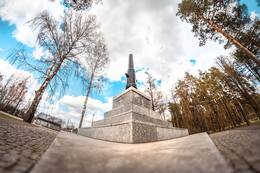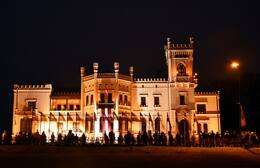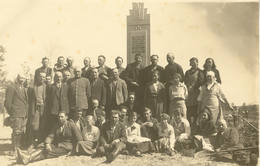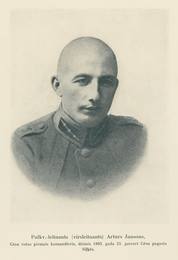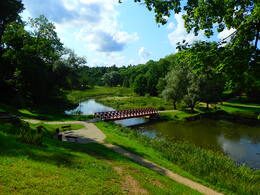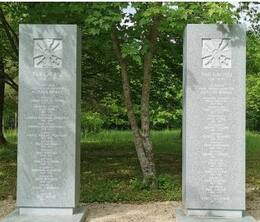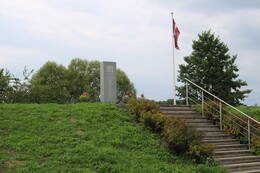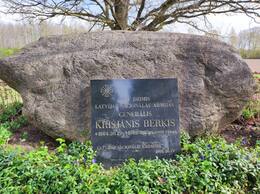Liūto ordinas I WW1, I Nepriklausomybės karai
Aukščiausias Latvijos karinis apdovanojimas – Lačplėšio karo ordinas – buvo įsteigtas 1919 m. lapkričio 11 d., pagerbiant bermontiečių pralaimėjimą Dauguvos upės pakrantėse ir Rygos išvadavimą. Lačplėšio karo ordinas tapo ir pirmuoju Latvijos valstybiniu apdovanojimu. Tačiau 1919 m. lapkričio 11 d. yra simbolinė ordino įsteigimo data, nes ordino įstatus 1920 m. rugsėjo 18 d. patvirtino Latvijos Konstitucinė Asamblėja. Pirmoji apdovanojimų ceremonija įvyko praėjus metams po Torniakalnio išvadavimo – 1920 m. lapkričio 11 d. Esplanadoje. Jis buvo įteiktas Latvijos armijos kariams, buvusiems Latvijos šauliams ir užsieniečiams, pagerbiant jų indėlį į kovą už Latvijos nepriklausomybę. Pirmuosius Lāčplėsio karo ordinus gavo: generolas Pēteris Radziņš, pulkininkai ir pulkininkai leitenantai Mārtiņš Peniķis, Krišjānis Berķis, Jūlijs Jansons, Jānis Apinis, Oskars Dankers ir Jānis Puriņš.
Lačplėsio Karo ordino ženklas – baltai emaliuotas ugninis kryžius su raudonu ir auksiniu apvadu. Averse centrinis medalionas vaizduoja Lačplėsį, kovojantį su lokiu. Kryžiaus kampuose – sukryžiuoti kardai. Reverse medalione iškalta data „1919 m. lapkričio 11 d.“. Kryžiaus šakose išgraviruotas užrašas „Par Latviju“ – ordino šūkis. Kryžiaus galuose išgraviruoti inicialai HB – sidabrakalio Hermanio Bankso meistro ženklas. Ordiną puošia daugiasparnė sidabrinė žvaigždė, kurios centre – ordino ženklas. Muaro juosta su trimis vienodo pločio raudonomis ir keturiomis sidabrinėmis juostelėmis. Lačplėsio Karo ordinas yra trijų klasių – I, II ir III.
Lačplėsio karo ordino apdovanojimas galiojo iki 1928 m. lapkričio 11 d. Per šiuos aštuonerius metus Lačplėsio karo ordino I klasė buvo įteikta 11 asmenų (4 latviams ir 11 užsieniečių), Lačplėsio karo ordino II klasė – 61 asmeniui (18 latvių ir 43 užsieniečių), o LKO ordino III klasė – 2072 asmenims (1600 nacionalinės armijos karių, 202 buvusiems Latvijos šauliams ir 271 užsieniečiui). LKO kavalieriai turėjo nemažai privilegijų – teisę dėvėti karinę uniformą net ir išėjus į pensiją, nuolaidas perkant geležinkelio bilietus, teisę gauti atleidimą nuo mokesčio už mokslą valstybinėse mokyklose, nemokamą medicininę priežiūrą ir kt.
Iš viso Lačplėšio karo ordinu buvo apdovanotos trys moterys. Viena iš jų – garsioji latvių šaulė Līna Čanka, kurios gyvenimo istorija jau tapo legenda. Gimusi 1895 m. Rendos parapijos „Mežzīlē“ kaime, 1915 m. artėjant vokiečių armijai, L. Čanka su šeima paliko namus ir bėgo. Atvykusi į Rygą, ji priėmė tuo metu neįprastą sprendimą – kovoti su įsiveržiančia armija su ginklais rankose kaip Latvijos šaulių batalionų dalis. Pasinaudodama savo žuvusio brolio Janio dokumentais ir pažįstamo vaikino, kuris sėkmingai perėjo medicinos komisiją, palankumu, L. Čanka sugebėjo patekti į 3-iąjį Kuršo Latvijos šaulių batalioną. Tačiau netrukus L. Čankos bendražygiai pranešė viršininkams apie neįprasto elgesio šaulį. Kai viskas paaiškėjo, L. Čanka norėjo būti pašalinta iš bataliono, tačiau protestavo, išreiškė norą kovoti su priešu ir netgi grasino nusišauti. Dėl to L. Čankai buvo leista likti batalione.
Daugiau informacijos šaltinių
Sargs.lv. 2015. Latvijos šauliai — Lačplēsio karo ordino kavalieriai. Prieinama: https://www.sargs.lv/lv/vienibas-un-personibas/2015-11-23/latviesu-strelnieki-lacplesa-kara-ordena-kavalieri#lastcomment [žiūrėta 2021-05-06].
Sielų audra. Lačplėsio karo ordinas, 1919–1928 m. Prieinama: https://www.dveseluputenis.lv/lv/laika-skala/notikums/124/lacplesa-kara-ordenis-1919-1928/ [žiūrėta 2021-05-06].
Sargs.lv. 2011. Lāčplėsio karo ordinas. Prieiga: https://www.sargs.lv/lv/vesture/2011-04-18/lacplesa-kara-ordenis#lastcomment [žiūrėta 2021 05 06].
Historia.lv. 2014. Lāčplėsio karo ordinas. Prieiga: https://www.historia.lv/biblioteka/skirklis/lacplesa-kara-ordenis [žiūrėta 2021 05 06].
Susijusi laiko juosta
Susijusios vietos
Generolo Pēterio Radziņa memorialinė vieta
Įsikūręs Valkos valsčiuje, važiuojant keliu Valka–Rūjiena (P22) 4 kilometre, pasukite į dešinę, sekant nuorodas.
Pēteris Radziņš gimė 1880 m. gegužės 2 d. Lugažių parapijos „Jaunvīndedzēs“. Mokėsi Lugažių parapijos mokykloje, Valkos miesto mokykloje ir Valkos Nelsono realinėje mokykloje. Savanoriu įstojo į Rusijos armiją. 1919 m. rudenį grįžo į Latviją ir spalio 27 d. buvo paskirtas Vyriausiojo armijos vado štabo viršininku, šias pareigas užimdamas tuo metu, kai bermontininkai kėlė grėsmę Rygai. Būdamas štabo viršininku, jis vadovavo visiems mūšiams Rygoje, Žiemgaloje ir Latgaloje. 1920 m. vasario 5 d. buvo paaukštintas generolu.
Šiandien šalia šeimos namų galima pamatyti generolui Pēteriui Radzinšui (1880–1930) skirtą atminimo akmenį.
2017 m. lapkričio 11 d. Rygoje, Dauguvos vartų kampe, buvo atidengta memorialinė lenta Pēteriui Radžiniui.
Vaizdo įrašas: Generolo P. Radzinio atminimo renginys Rygos brolių kapinėse 2019 m.
Vaizdo įrašas: 2019 m. gegužės 2 d., minint generolo Pēterio Radzinio 139-ąsias gimimo metines, Lapkričio 11-osios krantinėje, netoli Prezidento rūmų, vyko atminimo renginys, kuriame garbės sargybos stulpai ir susidomėję asmenys apsupo atminimo lentą.
Valkos kraštotyros muziejaus ekspozicijoje „Valka – Latvijos nepriklausomybės lopšys“ taip pat atsispindi generolo Pēterio Radzinio gyvenimas ir veikla.
Be tradicinių kolekcijos eksponavimo būdų, parodoje naudojami interaktyvūs multimedijos sprendimai. Informacija ir anotacijos verčiamos į estų ir anglų kalbas.
Oskaro Kalpako muziejus ir memorialinė vieta „Airītes“
Oskaro Kalpako muziejus ir memorialinė vieta „Airītes“ yra tarp Saldaus ir Skrundos, netoli greitkelio A9. Parodoje pateikiama išsami informacija apie pulkininką Oskarą Kalpaką ir jo batalioną, taip pat pristatoma Latvijos nacionalinės armijos ir memorialinės vietos „Airītes“ istorija. Parodoje pulkininką Oskarą Kalpaką pristatoma kaip asmenybę, kaip karį ir kaip kovotoją už Latvijos nepriklausomybę. Parodoje taip pat yra garso įrašų latvių, anglų ir vokiečių kalbomis. Juose pabrėžiama 1918/1919 m. istorinių įvykių svarba saugant Latvijos valstybingumą. Muziejaus pastatas yra restauruotas.
Įėjimas nemokamas; ekskursija su gidu – mokama. Komplekse yra poilsio zona, parkas, kliūčių ruožas, galima lankyti įvairius užsiėmimus, yra seminarų salė iki 30 žmonių.
Alūksnės įgulos kapinės
Įsikūręs Alūksnės ežero pakrantėje, Kapsėtos pusiasalyje, Didžiųjų kapinių teritorijoje.
Jie pradėti kurti ir prižiūrėti 7-ojo Siguldos pėstininkų pulko karių rūpesčiu XX a. 4-ajame dešimtmetyje ir pašventinti 1932 m. lapkričio 11 d. Atkūrus Latvijos nepriklausomybę, Garnizono kapinių priežiūros, su Alūksne susijusių LKOK poilsio vietų nustatymo ir atminimo ženklų Garnizono kapinėse įrengimo ėmėsi Alūksnės brolių kapinių komiteto skyriaus vedėjas Uldis Veldre.
Garnizono kapinėse palaidoti Latvijos Respublikos armijos kariškiai, taip pat kareiviai ir civiliai, žuvę kovose su bolševikais 1941 m. liepos 4 d. Alūksnėje prie Jāņkalninio ir 1941 m. liepos 7 d. Ziemerso valsčiuje prie Prindulių namų.
Daugumoje palaidotųjų yra balti mediniai kryžiai su metalinėmis lentelėmis, kuriose nurodytas mirusiojo vardas, pavardė, rangas ar profesija, taip pat gimimo ir mirties datos.
1990 m. gruodžio 19 d. Garnizono kapinėse buvo atidengta atminimo lenta Lačplėšio karo ordino kavalieriui Viliui Spandegui. Tipinės atminimo lentos taip pat buvo įrengtos LKOK nariams, žuvusiems arba nužudytiems komunistinėse koncentracijos stovyklose ir nepalaidotiems Latvijoje. 1990 m. lapkričio 11 d. buvo įrengta atminimo lenta LKOK nariui Voldemarui Zakiui, žuvusiam komunistinėje koncentracijos stovykloje.
Karvos brolių kapinės
Įsikūręs Alūksnės–Apės kelio pakraštyje, netoli Zuši mājas, į pietus nuo Karvos, ties posūkiu į Rezaką.
Paminklas atidengtas 1937 m. rugsėjo 12 d. Granito stela buvo pagaminta O. Dambekalno akmens karjere Rygoje pagal Karo statybos valdybos architekto Vemerso Vitando projektą.
1975 m. rudenį vietos komunistai paminklą sunaikino. 1989 m. kovo 30 d. Alūksnės rajono taryba priėmė sprendimą paminklą restauruoti, o 1989 m. balandžio 30 d. jo vietoje buvo įrengtas laikinas medinis paminklas – latviško antkapio formos, kurį pagamino Valstybinės elektros gamyklos (VEF) darbininkas Jānis Jaunzemsas. Ant jo buvo užrašas: „Čia bus restauruotas Karvos brolių kapinių paminklas“.
Tuo metu buvo sutvarkytos ir netoliese esančios Brolių kapinės.
1993 m. Alūksnės brolių kapinių komiteto vadovo Uldos Veldre iniciatyva buvo atnaujinti memorialinės vietos restauravimo darbai. Naująjį paminklą pagamino Cėsių akmentašiai broliai Aivaras, Austris ir Auseklis Kerliniai.
Paminklas buvo atidengtas 1994 m. birželio 11 d.
Broliškose kapinėse palaidoti keturi Valmieros pėstininkų pulko 5-osios kuopos kariai - Jēkabs Sukse, Pēteris Leitlands, Ernests Puķītis ir Gustavs Ozols, žuvę mūšiuose prie Zušių 1919 m. balandžio 2 d. Penktasis kareivis, palaidotas XX a. 4-ojo dešimtmečio viduryje, buvo Roberts Glazners, Valmieros pulko karys, dingęs be žinios 1919 m. kovo 31 d. netoli Jaunosios muižos. Iš pradžių jis buvo palaidotas kaip nežinomas, tačiau vėliau jo vardas buvo patikslintas ir iškaltas paminkle. Savo ruožtu penktasis Zušių mūšyje žuvęs karys Augusts Dzedons (Ziedons) palaidotas Apekalnos kapinėse.
Prie paminklo papėdėje įrengta atminimo lenta Ungurių mūšio dalyviui Janiui Goldesui (1891–1952), žuvusiam komunistų koncentracijos stovykloje Intoje, Komijoje.
Antroji atminimo lenta, atidengta 1992 m. rugpjūčio 23 d., yra įrengta prie vieno iš medinių kryžių ir skirta 7-ojo Siguldos pėstininkų pulko kapralui Pēteriui Jansonui, kurį 1941 m. liepos 7 d. nužudė pasitraukiantys komunistai.
Paminklas Nepriklausomybės kovų dalyviams ir žuvusiems
Yra Centro kapinėse, Barkavos parapijoje, Maduonos rajone.
Netoli Barkavos Šv. Stanislovo Romos katalikų bažnyčios.
Eksponuojamas paminklas Latvijos Nepriklausomybės kovų dalyviams ir žuvusiems. Paminklas atidengtas 2018 m. lapkričio 11 d. Jį sukūrė Barkavos pradinės mokyklos istorijos mokytojos Janīnos Liepinės iniciatyva.
Jis pagamintas iš juodo, poliruoto granito ir susideda iš kryžiaus, prie kurio abiejose pusėse pritvirtintos dvi atminimo lentos, kuriose išgraviruoti 47 vietos gyventojų, dalyvavusių Latvijos Nepriklausomybės kare, jame kritusių arba gavusių Lačplėšio karo ordiną, vardai ir pavardės, taip pat bolševikų nužudytų Barkos gyventojų vardai.
Netoliese galite pamatyti: paminklą Nepriklausomybės kare žuvusiam kareiviui Jezupui Reidzanui ir paminklą Aleksandrui Lakstīgalui, 1-ojo Liepojos pėstininkų pulko kareiviui.
Aleksandro Lakstigalo paminklas buvo atidengtas 1936 m. rugpjūčio 30 d. Jį atidengė 17-ojo Rėzeknės gvardijos pulko vadas Zaranas.
Paminklą 1-ojo Liepojos pėstininkų pulko kareiviui pastatė 17-ojo Rėzeknės gvardijos pulko 10-oji kuopa už paaukotas lėšas.
Lačplėsio karinio ordino kavalerių atminimo stela
Randamas Matīšu kapinėse, Matīšu parapijoje.
Atminimo steloje įrašyti 15 Lačplėšio karo ordino riterių vardai, susiję su Matīšiais, taip pat su kaimyninėmis Vilzenų ir Braslavos parapijomis, kurias kadaise vienijo Matīšių bažnyčios parapija. Taip pat identifikuoti tie, kurie mirė užsienyje arba buvo palaidoti kitose Latvijos vietose, bet čia, Matīšiuose, yra šeimos kapinės.
Atminimo stela buvo atidengta 2018 m. rugpjūčio 4 d., minint Latvijos šimtmetį.
Lačplėsio karo ordinas (LKO) buvo aukščiausias Latvijos karinis apdovanojimas nuo 1920 iki 1940 metų. LKO buvo skiriamas už kovinius nuopelnus Latvijos armijos ir buvusių Latvijos šaulių pulkų kariams, taip pat užsieniečiams, kurie labai prisidėjo prie Latvijos laisvės kovos ar kitaip prisidėjo prie Latvijos valstybės sukūrimo. LKO šūkis yra „Už Latviją“, ir jis turi 3 laipsnius. Pirmasis laipsnis skiriamas tik aukšto rango valstybės veikėjams ir generolams.
Latvijos legionierių ir Nepriklausomybės kare žuvusiųjų palaidojimai
Įsikūręs Cesvainės Ķinderų kapinėse.
Galima apžiūrėti granito atminimo akmenį Latvijos legionieriams, atidengtą 1997 m. birželį brolijos kapinėse, taip pat rasti ir apžiūrėti atskirus Nepriklausomybės kare žuvusiųjų palaidojimus.
Kapinėse įrengta informacinė lenta su žuvusiųjų memorialų ir laidojimo vietų schema:
1. Latvijos legionierių kapinės 1943–1945 m.
2. Jēkabs Markovs 1883 02 08-1917 08 08. 8-ojo Valmieros latvių pulko šaulys
3. Arvīds Alberts Strads, „Žaliųjų“ partizanų vadas, 1894 09 22-1919 04 05. Pirmasis leitenantas
4. Harijas Lezons 1914 03 18-2003 01 19. kapitonas
5. Jānis Purēns 1887 11 15 - 1918 11 18. Lāčplės karo ordino kavalierius.
Lačplėsio karinio ordino kavalerių palaidojimai Palsmanės kapinėse
Įsikūręs Palsmanės kapinėse.
Galima apžiūrėti 7 Lačplėsio karinio ordino riterių palaidojimus.
Projekto „Palsmanės kapinių skaitmeninimas“ dėka lankytojai gali rasti Lačplėsio karinio ordino riterių laidojimo vietas:
Individualus Rūdolfo Beitiko laidojimas, LKOK
Individualus LKOK Kārlis Brītiņš laidojimas
LKOK Roberto Kukurītio individualus laidojimas
Brolių LKOK Jūlijos Zīlės ir LKOK Rihardo Zīlės individualūs palaidojimai
Ernesto Lielmanio, Lietuvos stačiatikių bažnyčios nario, individualus laidojimas
Individualus LKOK Pēterio Rabaco laidojimas
Individualūs palaidojimai žemėlapyje pažymėti žvaigždute.
2019 m., minint Lačplėsio karo ordino įkūrimo 100-ąsias metines, taip pat pagerbiant regiono karius, apdovanotus Lačplėsio karo ordinu, lapkričio 11 d. buvo iškilmingai atidarytos Palsmanės kapinėse sukurtos atminimo vietos.
Pastatyti atminimo ženklai ir informaciniai stendai apie regiono LKO kavalierius.
Paminklas Smilteno gyventojų, žuvusių Nepriklausomybės kare, atminimui
Įsikūręs Smiltenės liuteronų kapinėse, Vaļnių gatvėje 11.
Paminklas Smilteno žmonėms, žuvusiems Nepriklausomybės kare, atminti buvo atidengtas ir pašventintas 1937 m. lapkričio 7 d. Paminklas pastatytas iš betono ir dengtas Allažių travertino plokštėmis. Paminklą suprojektavo architektas Verners Witands ir skulptorius Matīss Plukas.
Priešais paminklą 1937 m. spalio 31 d. iš šeimos kapo buvo perlaidoti 1919 m. kovo 6 d. Airītės mūšyje žuvusio Lačplėsio karo ordino kavalieriaus leitenanto Pēterio Krievo palaikai. 1937 m. lapkričio 7 d. prie jo kapo buvo pastatyta juodo granito atminimo lenta.
Kapinėse palaidoti keli Nepriklausomybės kare žuvę Latvijos šauliai ir Latvijos armijos kariai. Smiltenės evangelikų liuteronų bažnyčioje, abiejose altoriaus pusėse, 1927 m. spalio 2 d. dekanas Kārlis Kundziņš pašventino 2 balto marmuro atminimo lentas.
Lāčplėsio karinio ordino generolų ir riterių atminimo vietos Trikātos valsčiuje
Atminimo stela yra šalia Trikatos kapinių koplyčios.
Trikātos kapinėse saugomas trijų iškilių Latvijos generolų – Roberto Dambīčio, Kārlio Gopperso ir Jānio Balodžio – atminimas. Trikātos kapinėse palaidotas ir visų šių generolų mokytojas Jēkabs Mūrnieks, kuriam 1928 metais palaidojimo vietoje buvo pastatytas paminklas iš travertino, sukurtas pagal Kārlio Zāle pavyzdį.
Lačplėsio karinio ordino generolai ir riteriai kasmet pagerbiami fakelų procesijomis į Trikatos kapines, kur yra dvi atminimo stelos, kuriose iškalti 17 su Trikatos parapija susijusių Lačplėsio karinio ordino riterių vardai.
Stela buvo atidengta 2018 m. lapkričio 11 d.
Vaizdo įrašas apie Lāčplės karo ordiną ir ordinų rinkinį , priklausiusį generolui Jāniui Balodiui.
Lačplėsio karinio ordino kavalerių atminimo stela
Įsikūręs šalia Kauguri kapinių koplyčios.
Galima apžiūrėti memorialinę stelą ir informacinį stendą su kiekvieno Lačplėšio karo ordino riterio biografija, mūšio vietomis ir poilsio vieta.
Ant stelos užrašytas tekstas yra kiek klaidinantis, nes Kaugurių kapinėse palaidoti tik du LKOK – A. Ābeltiņš ir Ē. Radziņš, o kiti steloje paminėti su Kaugurių parapija susiję kitaip – arba ten gimė, arba kurį laiką ten gyveno.
Lačplėsio karo ordinas (LKO) buvo aukščiausias Latvijos karinis apdovanojimas nuo 1920 iki 1940 metų. LKO buvo skiriamas už kovinius nuopelnus Latvijos armijos ir buvusių Latvijos šaulių pulkų kariams, taip pat užsieniečiams, kurie labai prisidėjo prie Latvijos laisvės kovos ar kitaip prisidėjo prie Latvijos valstybės sukūrimo. LKO šūkis yra „Už Latviją“, ir jis turi 3 laipsnius. Pirmasis laipsnis skiriamas tik aukšto rango valstybės veikėjams ir generolams.
Stela buvo atidengta 2018 m. lapkričio 11 d.
Paroda „Latvijos armija Pliavinėse XX amžiuje“.
Adresas: Odzienas g. 2, Pļavinės.
Eksponuojama nuolatinė ekspozicija „Latvijos armija Pliavinėse XX amžiuje“.
Pastatas Pliavinėse, Odzienos gatvėje 2, turi ilgą istoriją – nuo tada, kai „Stukmaņi“ didmenininkas „Hugo Apeltofts“ pradėjo jame aktyvią ūkinę veiklą ir taip prisidėjo prie Pliavinių miesto plėtros, iki to momento, kai Nepriklausomybės karo metu čia buvo įkurtas Latvijos Rytų fronto štabas. 1919 m. būtent iš Pliavinių buvo vadovaujamos Latvijos armijos dalinių operacijos prieš Raudonąją armiją Latgaloje.
1934 m. prie šių namų buvo atidengta memorialinė lenta su užrašu: „1919 m. šiuose namuose buvo įsikūręs Rytų fronto štabas, o čia generolas Janis Balodis perėmė vyriausiąją Latvijos nacionalinės armijos vadovybę.“ Sovietų valdžia ją 1940 m. pašalino ir sunaikino, tačiau 1990 m. birželio 16 d., padedant Latvijos nacionalinės išlaisvinimo armijos Pliavinės skyriui, ji buvo atstatyta.
Dabar šalia buvusio štabo pastato stovi memorialinė stela, skirta 15 Lačplėsio Karo ordino riterių, gimusių Pliavinos krašte, o patalpose sukurta paroda „Latvijos armija Pliavinoje XX amžiuje“, kurioje pasakojama apie Laisvės kovų įvykius, Latvijos armijos 3-iosios Latgalos divizijos štabo veiklą Pliavinoje, taip pat galima susipažinti su Lačplėsio Karo ordino riterių gyvenimo istorijomis.
Netoli parodų pastato yra Latgalos divizijos štabo pastatas, kurį 1913 m. kaip „Stukmanu“ likerio fabriką pastatė grafas Teodoras Medemas. 1919 m. jį perėmė P. Stučkos režimas, kuriame taip pat buvo įkurtas kalėjimas. Išvijus bolševikus, 1925 m. pastatą perėmė Latvijos armija, kurioje buvo įsikūręs Latgalos divizijos štabas. Šiame pastate savo karinę karjerą praleido 10 Latvijos armijos generolų ir kitų karininkų. 1940 m. pastatą perėmė Raudonoji armija. Pokario metais jame buvo įsikūrusi mokykla, taip pat savivaldybė. Apie 1970 m. pastatą pradėjo naudoti gamybos susivienijimas „Rīgas Apērbs“.
Parodą būtina apžiūrėti iš anksto telefonu 28442692.
Generolo Karlso Gopperso atminimo kambarys jo gimtinėje „Maskati“
Įsikūręs Plani valsčiuje, ant Vijos upės kranto.
Galima aplankyti generolo Kārlio Gopperso atminimo kambarį jo gimtinėje „Maskati“.
„Maskatu“ ūkį valdė generolo brolis Augustas Goppersas, nes talentingas karo vadas buvo užsiėmęs svarbiais įvykiais ir pasauliniais karais. 1920 m. generolas grįžo į Latviją, į gimtuosius namus. Tačiau daugelis atsakingų pareigų jį siejo su Ryga. Augustas toliau vadovavo „Maskatu“. 1940 m. generolas Goppersas buvo suimtas ir 1941 m. kovo 25 d. sušaudytas Čekos rūsiuose. 1944 m. Gopperių šeima su trimis arklių traukiamomis vežimais pabėgo į Kuršą. Karas išskyrė šeimą, o Aleksandro Gopperso dukros – Biruta, Elza ir Ana – liko Latvijoje. Joms nebebuvo leista grįžti į „Maskatu“. Namai buvo dideli ir kruopščiai prižiūrimi. Juose atskiruose kambariuose buvo apgyvendintos trys ar keturios naujokų šeimos. Dideliame tvarte buvo įrengtas arklių ferma. Dėl tarpusavio kivirčų 1980 m. kilo gaisras. Sudegė tvartas ir didelis sandėlis. Laimei, ugnis į namą nepersimetė, liepsnas atbaidė dideli mūsų protėvių sodinti medžiai.
1991 m., po stebuklingo Atgimimo, Latvijos valstybė atgimė antrą kartą. 1992 m. generolo Gopperso brolio Augusto šeima susigrąžino „Maskatus“ kaip savo protėvių šventą vietą. Dešimt metų visi sunkiai dirbo, kad išgelbėtų namus nuo sunaikinimo, atkurtų ir atstatytų sugriautus pastatus, kad visas „Maskatus“ ūkis būtų gražus. Namai buvo atkurti iki senovinės išvaizdos, taip pat įrengtas generolo Kārlio Gopperso atminimo kambarys. Atminimo kambarį galima aplankyti iš anksto paskambinus ir susitarus telefonu +371 29396870, +371 29254285.
Komunistinio teroro aukų atminimo vieta Jaunraunos valsčiuje
Įsikūręs „Baižėnuose“, Priekulių valsčiuje
Represuotųjų atminimo vieta įkurta „Baižēnių“ namo tvarto griuvėsių vietoje, kur 1949 m. kovo 25 d. naktį buvo laikomi 40 Jaunraunos parapijos gyventojų, kad ryte jų kelias vestų toliau į Lodės geležinkelio stotį ir Sibirą.
Tarp represuotųjų buvo vaikai iki 1 metų ir 87 metų amžiaus.
Atminimo lentoje taip pat įrašyti sušaudytųjų ar žuvusiųjų tremtyje vardai. Netoliese yra atminimo akmenys Lačplėšio karo ordino kavalieriams.
Lubanos savivaldybės turizmo ir kultūros paveldo centras
Lubanos savivaldybės turizmo ir kultūros paveldo centras yra pačiame Lubanos miesto centre. Jame yra keletas ekspozicijų, įskaitant nuolatines, apie savivaldybės istoriją, kultūrą, tradicijas ir renginius. Nuolatinės ekspozicijos skirtos asmenybėms, kuriomis Lubana ypač didžiuojasi. Jose pristatoma poetė Broņislava Martuževa, Nacionalinio pasipriešinimo judėjimo narė ir politinė kalinė; politikas Hugo Celmiņš, Nepriklausomybės kovų dalyvis; Oskaras Kalpaksas, pirmasis Latvijos armijos vyriausiasis vadas; fotografas Alfredas Grāversas; operos dainininkas Jānis Zābersas; poetas Jānis Gavarsas; menininkas Rūdolfs Pinnis, taip pat folkloristas ir pastorius Mārtiņš Celmiņšas. Gidas pasakoja apie Lačplėšio karo ordino riterių ir laisvės kovotojų gyvenimą Lubanoje ir gretimoje teritorijoje, taip pat apie jų poilsio vietas senosiose Lubanos kapinėse. Galimos kalbos: latvių ir rusų. Ekskursijas su gidu su vertimu į vokiečių ir anglų kalbas galima užsisakyti iš anksto.
Paminklas Nepriklausomybės kare žuvusiems kariams
Įsikūręs Valkoje, Varonių gatvėje, šalia Miško kapinių.
Galima pamatyti paminklą 30-iai 1-ojo (4-ojo) Valmieros pėstininkų pulko karių, žuvusių Latvijos Nepriklausomybės kare.
Paminklas atidengtas 1922 m. spalio 1 d. Jį sudaro iš vietinio rausvo granito išdrožta senovės latvių kario („Protėvio“) figūra, pastatyta ant dviejų dalių pilko granito pjedestalo. Paminklo projektą pasirinko skulptorius Emīls Melders (Miller). Kartu su Meldersu paminklo drožyboje dalyvavo ir skulptorius Vilhelms Treijs.
Tai pirmasis profesionalaus skulptoriaus sukurtas Latvijos Nepriklausomybės karo paminklas, taip pat vienintelis tarpukariu sukurtas modernistiniu stiliumi, naudojant kubizmo elementus.
Pakartotinės komunistinės okupacijos metu 1951 m. paminklinė skulptūra buvo nuversta, iš dalies apgadinta ir užkasta. Kapinės taip pat buvo sulygintos.
1988 m., artėjant skulptoriaus E. Melderso (1889–1979) šimtmečiui, buvo pradėtas jo darbų tyrimas.
Atkurtos brolių kapinės kartu su restauruotu paminklu buvo atidarytos 1990 m. lapkričio 11 d.
2017 m. brolių kapinėse buvo įrengtos aštuonios atminimo stelos su Valku susijusiems Lačplėsio karo ordino riteriams. Jos yra abiejose paminklo pusėse – po keturias stelas kiekvienoje pusėje.
Paminklas karinio jūrų laivyno leitenantui L.k.o.k. Vilis Gelbes (1890-1919)
Įsikūręs Limbaži Jūros gatvės kapinėse, Jūros g. 56, Limbaži
Eksponuojamas paminklas, kurį 1922 m. rugsėjo 10 d. atidengė tuometinis Latvijos prezidentas Janis Čakste, su poeto Vilio Plūdonio dedikacija Viliui Gelbui:
„Mano žmonės, kurie eina pro mane, dega meile savo tėvynei,
"Dėl savo mylimos tėvynės pažadu savo gyvybę."
Vilis Gelbė (1890–1919) gimė Kurše, Zemytės valsčiuje, tačiau buvo glaudžiai susijęs ir su Limbažių puse, nes prasidėjus Latvijos nepriklausomybės karui, iš Sankt Peterburgo grįžo į Latviją ir įstojo į Šiaurės Latvijos brigadą.
1919 m. gegužę V. Gelbis vadovavo Limbažiuose, tapo srities karo komendantu ir sugebėjo įkvėpti vietos vyrus ir net labai jaunus berniukus stoti į kariuomenę.
Tuo metu V. Gelbės veikla Limbažiuose ir apylinkėse buvo labai reikšminga; jo pareigos apėmė ne tik tvarkos palaikymą mieste ir apylinkėse, bet ir mobilizaciją, kareivių ir arklių aprūpinimą maistu bei daugelio kitų klausimų, kurie negalėjo būti įtraukti į įsakymus ir instrukcijas, sprendimą. Jo organizuota komendanto komanda veikė kaip koordinuotas mechanizmas, suteikiantis Šiaurės Latvijos brigadai kuo efektyvesnę pagalbą. Komendanto komanda ypatingais atvejais eidavo į pagalbą reguliariajai armijai, o naujiesiems kariams rodydavo pavyzdį. V. Gelbė buvo pirmasis Latvijos armijos karininkas, pasiūlęs savo pavaldinius apdovanoti III laipsnio Imantos ordinu. Ordino tuo metu dar nebuvo. Imantos vardas viešumoje pasirodė tik 1920 m. kovo 20 d., kai saugumo ministrui Kārliui Ulmaniui buvo pateiktas siūlymas dėl karinio ordino įsteigimo. Tačiau ordinui buvo pasirinktas Lāčplēsio vardas.
Cėsių mūšio metu Vilis Gelbė žuvo 1919 m. birželio 19 d. žvalgybos misijos metu. Vėliau Gelbė buvo apdovanotas Lačplėšio karo ordinu, tačiau istorikai mano, kad jo indėlis nebuvo tinkamai įvertintas. Taip yra daugiausia dėl Gelbės narystės Šiaurės Latvijos brigadoje.
Vadinamoji Pietų Latvijos brigada, kuriai iš pradžių vadovavo Oskaras Kaplakas, o vėliau – Janis Baložas, varžėsi su Šiaurės Latvijos brigada, kuriai vadovavo Jorgis Zemitānsas.
Paminklas Vidrižuose, toje vietoje, kur žuvo LKOK Vilis Gelbe ir du jo komandos kariai.
Vidrižuose, ties posūkiu į Lėdurgą, Nepriklausomybės kovų metu, 1919 m. birželio 19 d., mūšyje žuvo jūrų leitenantas Vilis Gelbė ir du kareiviai.
Vilis Gelbė palaidotas Limbažų kapinėse. Už didvyrišką poelgį prie Vidrižių dvaro Vilis Gelbė buvo apdovanotas Lāčplėsio karo III laipsnio ordinu (Nr. 895).
Šiuo metu mūšio vietoje galima pamatyti tris Pemino kryžius, įrengtus 1989 m.
1934 m. birželio 22 d. prie dvaro parke augančio klevo buvo atidengta bronzinė atminimo lenta, sukurta menininko Stefano Berco vardu. Jau komunistinės okupacijos pradžioje, 1940 m. rudenį, atminimo lenta dingo. Klevas, prie kurio ji buvo prikalta, taip pat žuvo. Prasidėjus Atbudimui, 1989 m. birželio 19 d., minint Gelbės ir dviejų jo komandos karių – kapralo Krustinio ir eilinio Krūzės – žūties 70-ąsias metines, kryžkelėje, kur kadaise stovėjo atminimo lenta, Aplinkos apsaugos klubo ir Latvijos liaudies fronto Limbažių rajono skyrių iniciatyva buvo pastatyti trys mediniai kryžiai, pagaminti Janio Eglītio liaudišku stiliumi. Limbažių rajono vykdomojo komiteto sprendimu 1991 m. balandžio mėn. ši atminimo vieta buvo įtraukta į vietinės reikšmės istorinių paminklų sąrašą.
Preilių istorijos ir taikomosios dailės muziejaus paroda „Muziejaus istorijos Latvijai“
Įsikūręs Preilių kultūros centro patalpose.
Preilių istorijos ir taikomosios dailės muziejuje (PVLMM) eksponuojama paroda „Muziejaus istorijos Latvijai“ apie Pirmąjį pasaulinį karą, Nepriklausomybės karą ir Antrąjį pasaulinį karą.
Preilių istorijos ir taikomosios dailės muziejaus ekspozicijos „Muziejaus istorijos Latvijai“ (atidarytos 2018 m.) skyrius „Dryvio istorija“ skirtas Pirmajam pasauliniam karui, Nepriklausomybės karui ir Latgalos išvadavimui, taip pat Lāčplēšanas karo ordino kavalieriams. Ekspozicijos skyrius „Vėliavos istorija“ pasakoja apie sudėtingus Antrojo pasaulinio karo įvykius, kurių metu Preilijos gyventojai nukentėjo nuo trėmimų, Holokausto, dalyvavimo kariaujančių šalių kariniuose daliniuose, o po karo – nacionalinių partizanų gretose. Taip pat eksponuojamas Preilių gyventojui ir žydų gelbėtojui Vladislavui Vuškanui įteiktas medalis „Pasaulio tautų teisuolis“.
Ekskursijos rusų ir anglų kalbomis teikiamos iš anksto susitarus.
Paminklas pirmajam žuvusiam Mokyklos kuopos kareiviui Edgarui Krieviniui
Įsikūręs Valmieros miesto centro kapinėse, šalia koplyčios (Miera g. 1/3, Valmiera)
Cėsių pulko 8-osios (Studentų) kuopos kareivis LKOK Edgaras Krieviņšas (1899–1919) mirė birželio 7 d. nuo sužalojimų, patirtų 1919 m. birželio 6 d. vykusiame Cėsių mūšyje, kai, priešui puolant, dengė likusių dalinių atsitraukimą.
Atminimo stela Lāčplėsio karo ordino kavalieriams
Įsikūręs šalia Švenčiausiosios Jėzaus Širdies Romos katalikų bažnyčios Viliake.
2017 m. lapkričio 11 d. Viliakos savivaldybėje buvo atidengta atminimo stela Lačplėsio karo ordino kavalieriams. Su Viliakos savivaldybės vardu susiję 28 Lačplėsio karo ordino kavalerių likimai.
Granito stela buvo sukurta įgyvendinant projektą „Prisiminkite Lačplėšį“, skirtą Latvijos valstybės šimtmečiui. Pagerbiant Latvijos Nepriklausomybės kare žuvusius karius, visoje Latvijoje bus įrengta uniformos modelio memorialinė stela. Projekto iniciatorius – Jaunimo gvardijos ir informacijos centras.
Penki Lačplėsio karo ordino riteriai, kurių vardai iškalti memorialinėje steloje, po Nepriklausomybės karo pabaigos gyveno dabartinio Viljakos rajono teritorijoje:
– Jānis Kuļšs buvo jaunas ūkininkas Apsīšuose, Šķilbenų valsčiuje,
– Aleksejus Ľubimovas (Lavrentjevs) gyveno Šķilbėnų valsčiaus Fortepjanovos vienkiemyje, vėliau – Viļakuose,
– Teodoras Mende tvarkė jam priskirtą ūkį ir buvo miškininkas Katleši kaime, Žīgurių valsčiuje,
– Eduardas Tenisonas gyveno Vecumu stotyje, vėliau Čabatrovos kaime ir dirbo „Viliakos“ pašte,
– Šķilbėnų valsčiuje kurį laiką gyveno Jānis Burmeistars po 1928 m.
Viliakos rajono Brolių kapinėse palaidoti 45 kariai, paaukoję savo gyvybes gindami Latviją nuo bolševikų 1920 m. Sausio 9 d. Šiaurės Latgaloje prasidėjo puolimai, ir nepaisant tuo metu vyravusių sunkių oro sąlygų, Viliaka tą pačią dieną buvo išlaisvinta.
Viliakos krašte vykusių Latgalos išlaisvinimo mūšių metu Estijos kareiviai petys į petį kovojo su Latvijos armijos kareiviais ir partizanais prieš Raudonąją armiją. Daugelis jų paaukojo savo gyvybes už laisvą Latviją.
Nygrande dvaro tvartas
Nygrandės kraštotyros saugykla yra Nygrandės kaime, dvaro tvarte, šalia Nygrandės pradinės mokyklos, ir yra prieinama iš anksto susitarus.
Saugyklos karo istorijos skyriuje įrengta paroda apie Antrąjį pasaulinį karą ir originalius daiktus bei dalis, rastus šioje vietovėje po karo ir vėlesniais metais. Taip pat galite sužinoti pasakojimų ir pamatyti nuotraukų apie Nygrande ir jos apylinkes iš Nepriklausomybės karo, Antrojo pasaulinio karo ir pokario laikotarpio, taip pat apie gyvenimą kolūkyje sovietmečiu.
Parodoje ypatinga vieta skirta vietos rašytojui Jėkabui Janševskiui ir jo kūrybai, taip pat veikia paroda, kurioje pristatomas tradicinis dvaro gyvenimas ir baldai. Nygrandės dvaro tvarte taip pat eksponuojama mamuto iltis, rasta Nygrandės mieste.
Livani išlaisvinimo paminklas
Paminklas yra Fabriko ir Stacijos gatvių sankryžoje, kur jį 1935 m. birželio 9 d. atidengė generolas Rūdolfas Bangerskis, pagerbdamas 1919 m. Lyvanų išvadavimo mūšiuose žuvusių karių atminimą.
Pagrindinis jo elementas – 15 tonų sveriantis vertikaliai pastatytas patrankos vamzdis. 1958 m. sovietų valdžia išardė Lyvanų laisvės simbolį, supjaustydama jį į metalo laužą. Gyventojai per visus sovietinius metus išsaugojo patrankos sviedinius, o po pusės amžiaus jie grįžo į ankstesnę vietą. Paminklo restauravimo idėja tarp žmonių gyvavo visus šiuos metus. Lyvanų krašto taryba kartu su gyventojais aktyviai dirbo restauruojant paminklą. Iš žmonių buvo renkamos aukos, o 2004 m. spalio 3 d. restauruotas Lyvanų išlaisvinimo paminklas buvo atidengtas istorinėje vietoje miesto parke.
Užrašas ant paminklo: „Jelgavos pėstininkų pulko kariai, žuvę už Latviją prie Lyvanų ir apylinkių išvadavimą 1919 m. Buvusio Šiaurės Latvijos partizanų pulko kariai.“
Toliau pateikiami kareivių ir partizanų vardai.
Netoliese įrengtos atminimo lentos Lyvanų rajono Lačplėsio karo ordino kavalieriams.
Paminklo projekto autorius buvo architektas Pāvils Dreimanis.
1919 m. spalio 3–5 d. Līvānų mūšis
1919 m. spalio 3 d. bolševikai patyrė stiprų smūgį fronte netoli Lyvanų. Lyvanų puolime dalyvavo 3-iojo Jelgavos ir 4-ojo Valmieros pėstininkų pulkų daliniai, taip pat Latvijos vokiečių landesvero (buvusio Landesvero) daliniai. Artilerijos remiami, 3-iojo Jelgavos pėstininkų pulko daliniai persikėlė per Dauguvą. Po sėkmingo persikėlimo prasidėjo visą dieną trukusios Lyvanų kautynės. Apie 17:30 val. buvo užimta Lyvanų stotis, o po valandos – perbraukti tiltai per Dubnos upę. Jungtinės pajėgos sugebėjo išstumti bolševikus iš Lyvanų, ir iki 19:00 val. miestas buvo visiškai išlaisvintas. 1919 m. spalio 5 d. bolševikai bandė atgauti Lyvanus, puldami naujas 3-iojo Jelgavos ir 4-ojo Valmieros pėstininkų pulkų pozicijas. Latviai sunkiai išlaikė užimtas pozicijas. Tai buvo pirmasis rimtas ir sėkmingas išpuolis Rytų fronte nuo 1919 m. liepos iki spalio mėn.
Būdami prie Lyvanų išlaisvinimo paminklo, galite nuskaityti QR kodą ir pasiklausyti garso įrašo apie paminklo istoriją. Pasakojimą taip pat galite rasti „IziTravel“ platformoje ČIA . Pasakojimas prieinamas latvių ir anglų kalbomis.
Alūksnės muziejus
Alūksnės muziejus įsikūręs nacionalinės reikšmės architektūros paminkle – neogotikinėje Alūksnės Naujojoje pilyje, pastatytoje XIX a. pabaigoje. Muziejuje veikia paroda „Totalitarinio režimo aukų memorialinis kambarys“, kurioje pasakojama apie Alūksnės savivaldybės gyventojų likimus Sibire ir Tolimuosiuose Rytuose, o laikotarpis nuo priešistorės iki šių dienų susitinka Alūksnės istorijos ekspozicijoje „Amžių šventė“. Joje yra atskiras skyrius, skirtas 7-ojo Siguldos pėstininkų pulko indėliui į kariuomenę, kultūrą ir visuomenės gyvenimą. 7-ojo Siguldos pėstininkų pulko formavimas prasidėjo 1919 m. birželio 20 d. Naukšėnų dvare. Iš pradžių iš Šiaurės Latvijos brigados rezervinio bataliono buvo suformuota 22 karininkų ir 1580 kareivių kovinė grupė, pavadinta Dankersų divizija. Ji buvo įtraukta į 3-iojo Jelgavos pulko 2-ąjį batalioną. Rugpjūčio 23 d., padidėjus kuopų skaičiui, jis tapo 7-ojo Siguldos pėstininkų pulko dalimi. Dalyvavęs mūšiuose prieš Bermontą, 1920 m. sausio 5 d. pulkas buvo perkeltas į Latgalos frontą kovoti su bolševikais. Pasirašius taikos sutartį su Sovietų Rusija, pulkas saugojo rytinę Latvijos sieną. Latvijos nepriklausomybės kare žuvo daugiau nei 200 pulko karių, o 85 buvo apdovanoti Lačplėšio karo ordinu. 1921 m. 7-asis Siguldos pėstininkų pulkas buvo dislokuotas Alūksnėje. Pulko štabas buvo įsikūręs Alūksnės naujojoje pilyje. Po Antrojo pasaulinio karo pilį perėmė sovietų saugumo institucijos. Nuo šeštojo dešimtmečio pabaigos pilyje buvo įsikūrusios įvairios kultūros įstaigos: Vykdomojo komiteto Kultūros ir kinematografijos skyrius, pionierių namai, biblioteka, kino teatras ir muziejus.
Paminklas Onos parapijos kariams, žuvusiems Pirmajame pasauliniame kare ir Latvijos išsivadavimo kare
Įsikūręs Anos parapijos Ezerinių kapinių centrinėje dalyje.
Kapinėse, kuriose laidojami nuo 1925 m., stovi paminklas, pastatytas iš Anos parapijos Sargybos skyriaus surinktų lėšomis ir 1933 m. atidengtas, skirtas Anos parapijos kariams, žuvusiems Pirmajame pasauliniame kare ir Latvijos išsivadavimo kare. Iki Antrojo pasaulinio karo paminklo priežiūra rūpinosi Anos parapijos sargybiniai, kurie kiekvieną sekmadienį eidavo į kapines ir, pagerbdami žuvusiuosius, dėdavo gėlių. 1940 m. lapkričio 18 d. paminklas buvo nugriautas, kulkų palikti pėdsakai vis dar matomi. Šiomis dienomis kapinėse kasmet rengiami Lačplėsio dienai skirti minėjimai.
2004 m. kapinėse atidaryta atminimo vieta 1941 ir 1949 m. politiškai represuotiems asmenims, o 2006 m. – atminimo lenta nacionaliniams partizanams.
Paminklas pirmojo Cėsių kuopos mūšio vietoje
Įsikūręs Drabešių valsčiuje, Vidžemės plento 79 kilometre.
Matomas iš granito pagamintas paminklas, kuriame iškalta stilizuota bolševikų invazijos maršruto schema.
Paminklas buvo atidengtas ir pašventintas 2018 m. gruodžio 28 d. Drabešių valsčiuje 1918 m. gruodžio 24 d. kapitono Artūro Jansono (1893–1941) žvalgybos komanda intensyvia kulkosvaidžių ugnimi sustabdė Raudonosios armijos žvalgybos puolimą iš Cėsių į Ierikius. Tai buvo pirmasis ginkluotas Latvijos kariuomenės susidūrimas su Sovietų Rusijos Raudonąja armija.
Misiņkalno karinio paveldo takas
Misinkalno gamtos parkas yra Aizputės mieste. Misinkalnas yra aukščiausia Aizputės miesto vieta. Jo aukštis siekia 95,4 m. Nuo viršūnės atsiveria vaizdingas miesto vaizdas. Misinkalno gamtos parkas iš pradžių pradėtas kurti XX a. Šiuo metu parko plotas yra apie 28 ha.
Parko teritorijoje yra kelios vietos ir memorialai, susiję su XX amžiaus įvykiais – Latvijos laisvės karuose žuvusių karių – Lačplėšo ordino kavalerių – memorialinė stela, Holokausto memorialo vieta, represuotųjų atminimo vieta ir žuvusių raudonųjų partizanų memorialinė lenta.
Parke galima susipažinti su įvairių retų rūšių augalais ir plantacijomis, taip pat mėgautis nepaliesta gamta. Šiuo metu parką raižo atnaujinti pėsčiųjų ir dviračių takai, o parko teritorijoje yra motociklų trasa, kurioje vyksta Latvijos motokroso varžybos.
Norint išsamiau pažinti Misiņkalno dvaro parko kultūrinį ir istorinį paveldą, rekomenduojame pasinaudoti gido paslaugomis.
Stelos Lačplėsio karo ordinų riterių atminimui
Su Aizputės regionu susiję dvidešimt septyni Lačplėsio karinio ordino riteriai.
Pagerbiant Latvijos Nepriklausomybės kare žuvusius karius, visoje Latvijoje buvo įrengtos vienodo modelio memorialinės stelos, kuriose teksto graviravimo šriftas atitinka didvyrių atminimo lentų standartą, analogišką Rygos brolių kapinių ir Centrinių kapinių lauko smiltainio atminimo ženklų graviravimui.
Granito stelos buvo sukurtos įgyvendinant Jaunosios gvardijos ir informacijos centro projektą „Prisimink Lāčplēšį“, skirtą Latvijos valstybės šimtmečiui.
Stela „Nepriklausomybės karo didvyriams“ Jaunjelgavoje
Jaunjelgavos krašte gimusiems Lačplėsio Karo ordino riteriams skirta atminimo lenta. Stela atidengta 2017 m. lapkričio 2 d. Maždaug dviejų metrų aukščio atminimo lentoje iškalti iš konkretaus regiono kilusių Lačplėsio ordino riterių vardai ir gyvenimo metai. Kitoje stelos pusėje yra tekstas: „Latvijos laisvės kovų didvyriams Latvijos šimtmečio proga“.
„Tokių standartinių atminimo ženklų, skirtų 1918–1920 m. Latvijos Nepriklausomybės karo didvyriams, įrengimas visuose Latvijos regionuose vyksta pagal projektą „Prisiminkite Lāčplēšius“, kurį praėjusiais metais inicijavo Gynybos ministerijos Informacijos centras ir Jaunoji gvardija. Maždaug dviejų metrų aukščio atminimo stela sukurta iš pilko suomiško granito pagal menininko Jānio Strupulio projektą.“
Generolo K. Berkio atminimo vieta
Generolo Krišjānio Berkio (1884–1942) paminklas pastatytas jo gimtinės vietoje prie ąžuolo. Paminklą 1998 m. balandžio 26 d. savo lėšomis pastatė Latvijos nacionalinė karių asociacija. Kr. Berkis buvo Latvijos armijos generolas, Latvijos šaulių vadas, kovojęs Pirmajame pasauliniame kare ir Latvijos Nepriklausomybės kare. Lačplėšio karo ir Trijų žvaigždžių ordinų kavalierius. Latvijos ginkluotųjų pajėgų vadas, Latvijos karo ministras.
Krišjānis Berkis gimė 1884 m. balandžio 26 d. Bērzukroge, Īslīcės valsčiuje. 1903 m., baigęs Bauskės miesto mokyklą, Kr. Berkis įstojo į Vilniaus junkerių mokyklą, kurią po 3 metų baigė kaip puskarininkis. Tarnavo 2-ajame Suomijos šaulių pulke Helsinkyje. 1909 m. Kr. Berkis gavo leitenanto laipsnį, 1913 m. – štabo kapitono, o 1917 m. sausį – kapitono. 1917 m. liepą Kr. Berkis gavo pulkininko leitenanto laipsnį ir tapo 6-ojo Tukumo Latvijos šaulių pulko bataliono vadu. Po Spalio revoliucijos Kr. Berkis buvo pašalintas iš pareigų ir trumpam įkalintas, tačiau paleistas vis dar buvo priverstas slapstytis nuo bolševikų tiek Suomijoje, tiek Rusijoje, kol galiausiai 1919 m. pavasarį grįžo į Latviją. 1919 m. kovo 21 d. Kr. Berkis, jau būdamas pulkininku – leitenantu, įstojo į Latvijos laikinosios vyriausybės ginkluotąsias pajėgas ir tapo rezervinio bataliono (vėliau 2-ojo Cėsių pėstininkų pulko), o nuo rugpjūčio – Latgalos divizijos vadu. 1919 m. spalį Kr. Berkis gavo pulkininko laipsnį. 1920 m. balandį Kr. Berkis buvo išrinktas Steigiamojo susirinkimo deputatu, tačiau mandato atsisakė. 1925 m. Kr. Berkiui buvo suteiktas generolo laipsnis. Iki 1934 m. jis dirbo armijos štabo administraciniame skyriuje, buvo Vidžemės divizijos vadas ir Rygos garnizono viršininkas. 1934 m. lapkritį Kr. Berkis buvo paskirtas armijos vadu, o 1940 m. balandžio 5 d. – karo ministru. 1940 m. birželio 20 d. Kr. Berkis buvo atleistas iš tarnybos, liepą suimtas, o rugpjūčio 9 d. kartu su sūnumi ir marčia deportuotas į Rusiją, kur 1941 m. birželį buvo įkalintas. Mirė 1942 m. liepos 29 d. Permės kalėjimo ligoninėje.
Susijusi istorija
Šiaurės Latgalos išlaisvinimas nuo bolševikų
1918 m. gruodžio 1 d. Raudonosios armijos daliniai, sudaryti iš raudonųjų šaulių dalinių, įsiveržė į Latvijos teritoriją. Siekdami apsaugoti savo namus, šeimas, gimtąjį kraštą ir išvengti teroro, Balvių apylinkių vyrai griebėsi ginklų ir patraukė į miškus, prasidėjo pirmųjų „žaliųjų“ grupių formavimasis. 1919 m. pavasarį, paskelbus mobilizaciją, daugelis Balvių apylinkių vyrų laikė nepriimtiną kovą sovietinėje Latvijos armijoje ir prisijungė prie „žaliųjų“ grupių. Buvo suformuotos Balvių, Silakrogo, Rugėjų, Teteru-Dūrupės ir Liepnos grupės. „Žaliųjų“ grupių veikla Balvių apylinkėse suaktyvėjo 1919 m. kovo mėn.
Apie nacionalinį patriotą pirmąjį leitenantą Vilį Gelbį
Pulkininko leitenanto Vilio Gelbės (1890–1919) likimas atspindi sunkią situaciją kuriant mūsų valstybę ir kariuomenę, taip pat šių įvykių vertinimą.
1918 m. lapkričio 18 d. paskelbus Latvijos valstybę, prasidėjo Latvijos nepriklausomybės karas ir ginkluotųjų pajėgų kūrimo darbai. Pirmosiose Latvijos savanorių kareivių gretose buvo Kurše gimęs jūrų leitenantas Vilis Gelbė.
Apie pirmąjį Latvijos armijos vyriausiąjį vadą Dāvidą Sīmansoną
Knygos „Latvijos armijos vadai“ esė įtikina, kad istorijai didelę įtaką daro konkretūs asmenys. Nors svarbiausių istorinių įvykių epicentre jie buvo trumpą laiką, tikri Latvijos patriotai, turėdami didelę karinę patirtį, sugebėjo daug nuveikti formuojant ir stiprinant Latvijos kariuomenę bei istorinių įvykių lūžio taškuose.
Ši istorija yra apie pirmąjį Latvijos armijos vyriausiąjį vadą Dāvidą Sīmansoną (1859–1933).
7-oji Siguldos pėstininkų pulko bermontiada, Didžiosios kunigaikštienės Valijos Veščūnos apdovanojimas Lāčplės karo ordinu Alūksnėje.
Po Latvijos nepriklausomybės karo didžioji seržantė Valija Veščuna už mūšius su bermontininkais prie Plānių namų 1919 m. lapkričio 19 d. buvo apdovanota Lačplėsio karo ordinu. Valija Veščuna buvo viena pirmųjų, perėjusių Lielupės upę, apšaudyta priešo.
Atminimo akimirka Garisono kapinėse
Atkūrus Latvijos nepriklausomybę, Alūksnės brolių kapinių komiteto vadovas Uldis Veldre ėmėsi rūpintis Garnizono kapinių priežiūra, nustatyti su Alūksne susijusias LKOK poilsio vietas ir įrengti atminimo ženklus Garnizono kapinėse.
Apie generolą Karlį Goppersą
Generolas K. Goppersas (1876–1941) buvo iškilus kareivis ir iškili asmenybė. Jis pasižymėjo kaip sėkmingas vadas, vadovavęs batalionams ir pulkams, didvyriškai vadovavęs savo šauliams kovose už Latvijos laisvę Pirmojo pasaulinio karo (1914–1919 m.) metu. Jis dalyvavo mūšiuose prie Tyreļpurvos, Ložmetējkalno ir ginant Rygą.
Generolo Janio Baložo gyvenimas po grįžimo iš tremties
Kai 1940 m. rusai bandė išspausti iš Latvijos vyriausybės palankią karinės bazės sutartį, kuri būtų beveik neįmanomą Latvijos armijos gebėjimą pasipriešinti Raudonajai armijai, generolas J. Balodis bandė gauti kai kurias sutarties pataisas. Tačiau tai nepavyko. Tačiau generolo priešininkai pasinaudojo šia aplinkybe, kad vėliau J. Balodį paverstų beveik išdaviku. Po konflikto su ministru pirmininku ir valstybės ministru K. Ulmaniu generolas 1940 m. balandžio 5 d. buvo atleistas iš karo ministro pareigų. Tuomet J. Balodis nusprendė dalyvauti Saeimos rinkimuose iš Demokratinio bloko, tačiau nieko iš to neišėjo, nes rinkimuose buvo leista dalyvauti tik vienam sąrašui – komunistų kandidatų sąrašui. Latvija tapo 14-ąja sovietine respublika.
Latvijos kariuomenės generolo, dukart Lāčplėsio karo ordino kavalieriaus Pēterio Radzinio atminimui.
Generolas Pēteris Radziņš gimė Lugažių valsčiuje, Valkos rajone, paprasto ūkininko šeimoje, kur išmoko dirbti lauko darbus. Jis buvo labai protingas jaunuolis, baigęs mokyklą pasirinko karą ir taip pradėjo savo karinę karjerą, gelbėdamas Latviją nuo Bermonto kariuomenės. P. Radziņš buvo vienas iškiliausių Latvijos armijos karininkų, apdovanotas daugybe Latvijos ir užsienio ordinų bei atminimo ženklų.
Aizporių dvaras Nepriklausomybės kovų metu
Aizporų pusdvaras, Aizputės rajonas, Kalvenės savivaldybė, yra vakariausia Latvijos vieta, į kurią atsitraukė pulkininko Oskaro Kalpako atskirasis batalionas.
Pusiaukelėje tarp Rudbāržių ir Kalvenės, pakelėje, yra Aizporės kapinės. Jose stovi paminklas ir 12 atminimo ženklų Oskaro Kalpakos bataliono savanoriams kariams.
Istoriniai įrodymai Līči – Laņģi skardžiuose
Kraštotyros entuziasto Aivaro Vilnio pasakojimo apie istoriją ir jos įrodymus, rastus Lodėje ir Liepoje, dabartinės Cėsių savivaldybės teritorijoje, fragmentai.




